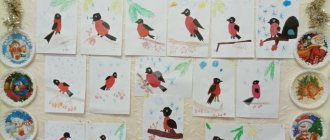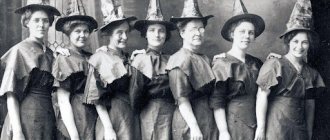Middle group
We offer didactic games for children “Geometric Shapes”, which can be used in the middle age group, that is, for pupils 4-5 years old.
Wonderful bag
Take a medium-sized bag of opaque material for the game, pick up several medium-sized objects that have a clearly defined geometric shape: a ball, a ball of thread, an apple, a box of pencils, a cube, a box of matches, etc. Put everything in a bag, ask your child to draw out only round-shaped objects, then only rectangular ones.
Geometric football
The game introduces preschoolers to two spatial objects: a ball and a cube. Build something like a football goal on the table. Ask your child to roll first the ball into the goal, then the cube. Then help the student draw conclusions: the ball has no corners, so it rolls easily; the cube is more difficult to move due to the presence of edges, but it is more stable on a horizontal surface.
House for a hedgehog
To play, cut out triangles of different sizes: take two paper squares - one larger, the other smaller, and cut them diagonally. Lay out the resulting figures in front of the student, tell them that autumn has come, the hedgehog is getting ready to fall asleep until spring, you need to help him build a cozy house from all the triangles presented.
Fish
Cut triangles from square sheets using the method described above. Ask your preschooler to make a fish out of the shapes. This can be done in several ways, the main thing is that the triangles should not intersect. If the child likes some version of the geometric fish more than others, you can make an applique out of it using glue.
Relay race
Divide the students into two teams. Each group of children stands in a row. Place a stool at the beginning of each row. At the other end of the room, place cardboard squares and triangles mixed together on the table.
When the start sounds, the players take turns running up to the table, grabbing the piece, and carrying it to their stool. The first team must collect squares, the second - triangles. The game ends when all players in one of the teams have participated in the relay. This team wins, but only if the pieces are assembled correctly.
Say it in one word
For the game, prepare groups of geometric shapes, united by shape, but with different other characteristics. For example, large and small rectangles, circles of different colors. Place objects on the table in groups of 4. The child must name them with a general word.
Arrange by size
For the game, make paired geometric shapes: one object in the pair is large, the second is small. Place two squares on the table. The student’s task is to place other objects on the squares according to their size. That is, you need to put large triangles, ovals, etc. on a large square, and equally small ones on a small one.
Didactic game “Find the figures”
For a board game, make paired cards depicting several geometric shapes. Take some pictures from the pairs and place the others on the table. Show the children the cards one by one, and they must find similar images on the table.
Find a house
For an active game, give the children a small geometric image: one is a circle, another is a square, another is a triangle, and so on. Place stools with corresponding shapes in different places in the playroom. Turn on music to which children should run around the room and dance. When the music stops, children must quickly find their “house,” that is, a stool, and run up to it. The game can be complicated: move the stools away so that the players do not notice it.
Didactic game “Shapes and Forms”
To play, print out geometric pictures. Show your child the shapes at random, and he must name the object of the corresponding shape. For example, having seen a circle, a student can name the following objects: apple, ball, orange, wheel, sun.
What's hidden
Place geometric images in front of the student. Let the preschooler look at them carefully, then close his eyes and not peek. Hide one of the pictures. The student, having opened his eyes, must remember which figure disappeared.
The purpose of the didactic game “Figures”
The card index lists games with many didactic functions that ensure the comprehensive development of the child. But their common goal is to form an idea of geometric shapes.
General tasks:
- memorization and comprehension of geometric figures;
- consolidation of ideas about colors and outlines of surrounding objects;
- development of visual, including color, spatial and planar perception;
- improving the skills of comparative analysis, classification, generalization;
- memory training, concentration, intelligence, and the ability to think logically;
- formation of the skill of ordinal counting, primary mathematical knowledge;
- improvement of finger motor skills, general physical development;
- expansion of individual vocabulary, development of the skill of detailed answers to questions;
- nurturing perseverance, determination, independence, observation, the ability to act according to rules and instructions, and work productively in a team.




